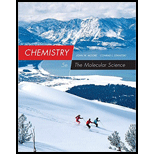
Concept explainers
Interpretation:
Age of the charcoal has to be calculated.
Concept Introduction:
For a radioactive isotope, the relative instability is expressed in terms of half-life. Half-life is the time required for half of the given quantity of the radioisotope to undergo radioactive decay. Half-life of the radioactive isotope is independent of the quantity of the radioactive isotope. Half-life of a radioactive isotope can be expressed as,
Number of disintegrations per unit time is known as the activity of the sample. The rate of radioactive decay can be expressed as,
Where,
If initial activity of the sample is
Rearranging equation (3) as shown below,
Considering equation (2), the equation (3) can be rewritten in terms of fraction of radioactive atoms that is present after time
Explanation of Solution
Mass of carbon present in
Half-life of carbon-14 is
Disintegration rate of carbon-14 is given as
The initial activity (
Age of the charcoal can be calculated as shown below,
Therefore, the age of the charcoal is estimated to be
Want to see more full solutions like this?
Chapter 18 Solutions
Bundle: Chemistry: The Molecular Science, 5th, Loose-Leaf + OWLv2 with Quick Prep 24-Months Printed Access Card
- 4.80 The reaction shown below is used to destroy Freon-12 (CF2Cl2), preventing its release into the atmosphere. What mass of NaF will be formed if 250.0 kg of CF2Cl2 and 400.0 kg of Na2C2O4 are heated and allowed to react to completion? CF2Cl2+2Na2C2O42NaF+2NaCl+C+4CO2arrow_forwardThe reusable booster rockets of the space shuttle use a mixture of aluminum and ammonium perchlorate as fuel. A possible reaction is 3Al(s)+3NH4ClO4(s)Al2O3(s)+AlCl3(s)+3NO(g)+6H2O(g) Calculate H for this reactionarrow_forwardConsider the two space shuttle fuel reactions in Exercises 81 and 82. Which reaction produces more energy per kilogram of reactant mixture (stoichiometric amounts)? 81. The reusable booster rockets of the space shuttle use a mixture of aluminum and ammonium perchlorate as fuel. A possible reaction is 3Al(s)+3NH4ClO4(s)Al2O3(s)+AlCl3(s)+3NO(g)+6H2O(g) Calculate H for this reaction 82. The space shuttle Orbiter utilizes the oxidation of methylhydrazine by dinitrogen tetroxide for propulsion: 4N2H3CH3(l)+5N2O4(l)12H2O(g)+9N2(g)+4CO2(g) Calculate H for this reactionarrow_forward
 Chemistry & Chemical ReactivityChemistryISBN:9781337399074Author:John C. Kotz, Paul M. Treichel, John Townsend, David TreichelPublisher:Cengage Learning
Chemistry & Chemical ReactivityChemistryISBN:9781337399074Author:John C. Kotz, Paul M. Treichel, John Townsend, David TreichelPublisher:Cengage Learning Chemistry & Chemical ReactivityChemistryISBN:9781133949640Author:John C. Kotz, Paul M. Treichel, John Townsend, David TreichelPublisher:Cengage Learning
Chemistry & Chemical ReactivityChemistryISBN:9781133949640Author:John C. Kotz, Paul M. Treichel, John Townsend, David TreichelPublisher:Cengage Learning ChemistryChemistryISBN:9781305957404Author:Steven S. Zumdahl, Susan A. Zumdahl, Donald J. DeCostePublisher:Cengage Learning
ChemistryChemistryISBN:9781305957404Author:Steven S. Zumdahl, Susan A. Zumdahl, Donald J. DeCostePublisher:Cengage Learning Chemistry: An Atoms First ApproachChemistryISBN:9781305079243Author:Steven S. Zumdahl, Susan A. ZumdahlPublisher:Cengage Learning
Chemistry: An Atoms First ApproachChemistryISBN:9781305079243Author:Steven S. Zumdahl, Susan A. ZumdahlPublisher:Cengage Learning
 Chemistry: The Molecular ScienceChemistryISBN:9781285199047Author:John W. Moore, Conrad L. StanitskiPublisher:Cengage Learning
Chemistry: The Molecular ScienceChemistryISBN:9781285199047Author:John W. Moore, Conrad L. StanitskiPublisher:Cengage Learning





